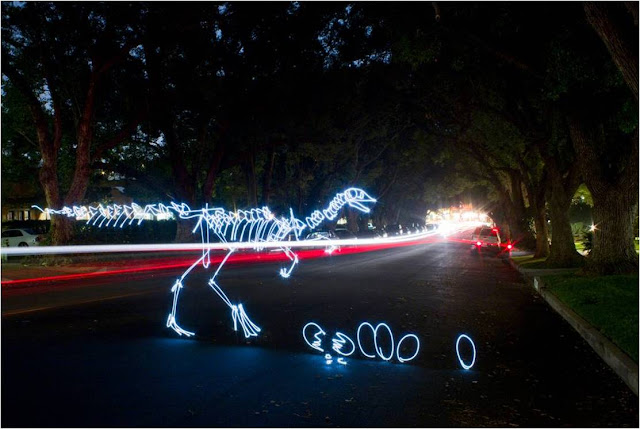16 October 2011
The Light Fossils of Darius Twin
As light painting increases in popularity, artists have been creating more and more sophisticated images using the technique. At the forefront of this movement is Los Angeles based graphic artist Darius Twin. His latest project, the creation of dinosaur fossils in light, is quite something to behold. You can see even more at his website too!
The technique involves exposures being made at night (or in a dark room) by moving a hand-held flashlight of the type that can be bought at any store. So far, so inexpensive but you will also need a camera with the ability to change the shutter speed to very slow – normal every day cameras will not do this. 10 seconds for the shutter speed will do - at least for a simple image. These amazing shots may well have taken longer!
One question which is asked a lot about light painting is why does the artist not show up on the pictures. It seems that you only show up if you cast light on yourself or sit still for too long. If you are quick and wear dark colors, you won't show up. That of course adds something else in to the equation – you have to be pretty sure of the shapes you are going to create beforehand. A sharp eye and a quick hand are, it seems, prerequisites.
Although the digital age offers opportunities which could only have been dreamed of in years gone by, light painting is hardly a new art from. It can be traced back as far as 1914 when a husband and wife team, Frank and Lillian Gilbreth first used the technique to track the motion of clerical workers. It was not until 1935 and Man Ray in his Space Writing series that the form was used artistically. Even Picasso got in on the act for a short time.
Coming up to date in 2011 the light fossils that you can see here have helped to move light painting on to a new level and one in which artists create ever more sophisticated works of art. We would like to thank Darius Twin for his kind permission to reproduce some of his photographs here – above is a slide show direct from his Flickr photostream including more of these startling images. Also, please don't forget to pay his excellent website, dariustwin.com a visit!
The technique involves exposures being made at night (or in a dark room) by moving a hand-held flashlight of the type that can be bought at any store. So far, so inexpensive but you will also need a camera with the ability to change the shutter speed to very slow – normal every day cameras will not do this. 10 seconds for the shutter speed will do - at least for a simple image. These amazing shots may well have taken longer!
One question which is asked a lot about light painting is why does the artist not show up on the pictures. It seems that you only show up if you cast light on yourself or sit still for too long. If you are quick and wear dark colors, you won't show up. That of course adds something else in to the equation – you have to be pretty sure of the shapes you are going to create beforehand. A sharp eye and a quick hand are, it seems, prerequisites.
Although the digital age offers opportunities which could only have been dreamed of in years gone by, light painting is hardly a new art from. It can be traced back as far as 1914 when a husband and wife team, Frank and Lillian Gilbreth first used the technique to track the motion of clerical workers. It was not until 1935 and Man Ray in his Space Writing series that the form was used artistically. Even Picasso got in on the act for a short time.
Coming up to date in 2011 the light fossils that you can see here have helped to move light painting on to a new level and one in which artists create ever more sophisticated works of art. We would like to thank Darius Twin for his kind permission to reproduce some of his photographs here – above is a slide show direct from his Flickr photostream including more of these startling images. Also, please don't forget to pay his excellent website, dariustwin.com a visit!

















